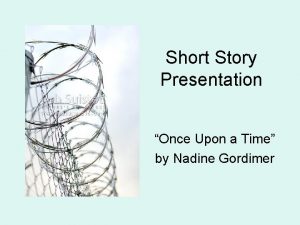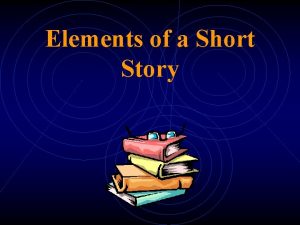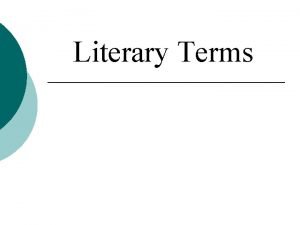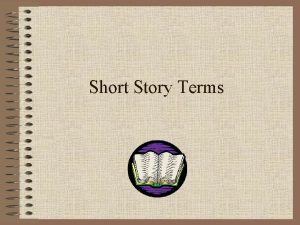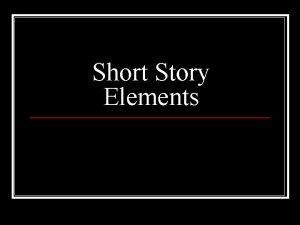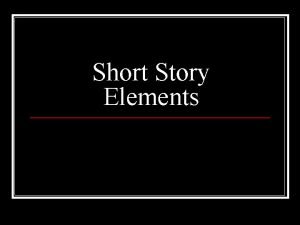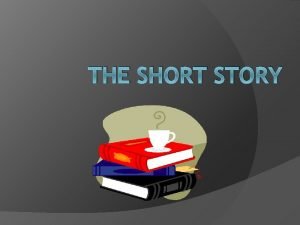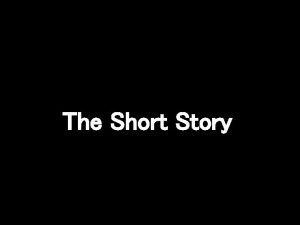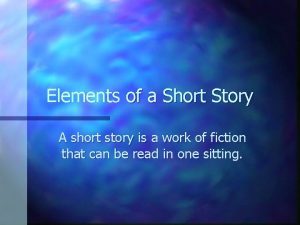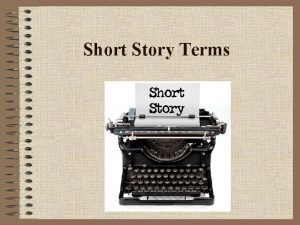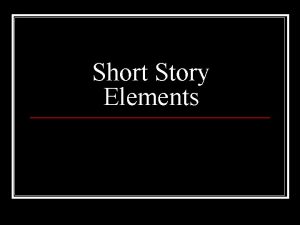Short Story Writing Short Story Introduction The short




























- Slides: 28

Short Story Writing

Short Story Introduction • The short story is a very specific genre with very specific criteria • It follows the plot curve. • It is meant to be read in one sitting 30 minutes to 1 hour. • It has one main character and one main conflict

Short Story Writing Tips • Get the reader hooked IMMEDIATELY! You don’t have a lot of pages for background and exposition like you would in a novel. • Try focusing on a specific time in your main character’s life instead of his/her entire life. • If a line or piece of dialogue is not developing your character or pushing your plot forward, leave it out!

The Rudimentary Outline • Put a man up a tree • Start with a clear situation – a problem your protagonist must get resolved • Throw stones at him • Show the problems, misunderstandings, lost opportunities, catastrophes, etc. • Get him down • Solve the conflict in some way: happy, sad, surprising, etc

Creating Characters • Before you begin writing, create a character sketch for your main characters (most importantly your protagonist & your antagonist) • Include the following in your sketch: • • • Name Age Height Eye color Hair color What is the character’s major goal? • Why is this goal so important to the character? • Are there any events in the character’s past that affect the significance of this goal/have influenced this goal? • Describe your character’s life till now, motivations, family situation, pet peeves, typical day, vices, nickname, strengths, weaknesses.

Directions: Explore Your Characters Complete the 1 st exercise. Then, choose 1 other exercise to complete for your short story characters (created in previous exercise). • Your protagonist and antagonist are each required to write a letter of introduction for your reader, describing themselves, their goals and motivations. • Your main character has invited you to lunch. Where does he/she meet you? What is ordered? What do you talk about? • It's a Sunday afternoon and your character's responsibilities are complete. What does he/she do to relax for the rest of the day? • Your protagonist and antagonist each write a letter to a friend or family member (or you!) about the other. • Your two main characters have to change a flat tire, in the rain. • Your main character invites you to his/her place for dinner. What sort of home does he/she have? How is it furnished? Any family, roommates, pets? What is served?

I Love My Voice Develop your character’s voice Directions: Choose 2 situations for which you free write the internal thoughts of your characters (created in 1 st exercise). Your writing for each situation should be roughly a ½ page. What does he or she think about when: • Getting up in the morning. • Getting ready to meet a friend. • After an argument with spouse or significant other. • Doing a mindless chore, like vacuuming. • Driving in rush hour traffic.

Set the Scene • The setting can be one of the most powerful tools in your story. • Setting function as: – the backdrop – a character • Capture your readers right away by describing your setting using active voice instead of passive voice. • Enhance your description with appropriate similes, metaphors, and personification. • Don’t hesitate to bring your characters in as part of your setting description.

Create a “home” for your characters Directions: 1. 2. complete the following exercises to help develop setting writing Create a floor plan for your character’s home/apartment. Draw some simple, boxed-out rooms, label each room (master bedroom, kitchen, youngest daughter’s room, etc) and make notes about what may be in there. “Give a tour” of the house…in writing (obviously ). Begin at the front of the house and describe each room and its contents as if you were giving a stranger a tour of your home.

Take a sensory approach Directions: • • describe the following areas using all five of your senses Kitchen Times Square The Beach A Train

A Distraught Description Write a one-page description of the following situation: A middle-age man is waiting at a bus stop. He has just learned that his son has died violently. Describe the setting from the man's point of view WITHOUT telling your reader what has happened. How will the street look to this man? What are the sounds? Odors? Colors? That this man will notice? What will his clothes feel like?

Define your Point of View? • 1 st person: told by the main character from an “I” perspective. – “Unites narrator and reader through a series of secrets” when they enter one character’s perceptions. However, it can “lead to telling” and limits readers connections to other characters in the short story. • 3 rd person: told by one “on-looking” character from the “he, ” “she, ” “it” perspective. – “Offers the intimacy of one character’s perception. ” However, the reader must deal with the “character’s absence from particular scenes. ” • 3 rd person Omniscient: told by an “all-knowing” & “God-like” narrator from the “he, ” “she, ” “it” perspective. – Allows you to explore all of the characters’ thoughts and motivations. Transitions are extremely important as you move from character to character. http: //jerz. setonhill. edu/writing/creative 1/shortstory /

What’s your point of view? Directions: Write about ONE of the following situations in the 3 different POV styles. v A thunderstorm v A divorce v A wedding reception v A classroom v A sunrise v A sunset v A team victory

Meaningful dialogue • Each speaker gets his/her own paragraph, and the paragraph includes whatever you wish to say about what the character is doing when speaking. • The dialogue should propel the story forward and divulge information about the characters, conflicts, or setting of the story. It SHOULD NOT be idle chatter… • The narrative between the dialogue should also have purpose. • Use strong dialogue tags (he said…she said variants)

Correct or Incorrect? “Where are you going? ” John cracked his knuckles while he looked at the floor. ! “To the ! T racetrack. ” Mary edged toward. Cthe door, E R keeping her eyes on John’s bent head. “Not R O again, ” John stood up, flexing his fingers. C N I “We are already maxed out on our credit cards. ”

Correct or Incorrect? – “Where are you going? ” John e asked nervously. r usaid, trying to figure out t “To the racetrack, ” Mary c ru to let her get whether John was too upset away with it t s S s t … this time. e t n l c e u e e r e s b “Not again, ” said John, wondering how they r u w o t h C e would make that month’s rent. “We are already c b u n i maxed out on our credit mcards. ” e o v i o t T ra r a n

Re-Write the dialogue John sat up and took a deep breath, knowing that his confrontation with Mary had to come now, or it would never come at all. “Wh– where are you going? ” he stammered nervously, staring at his Keds. • In the above text the writer is telling the reader too much. • Re-write the above passage to convey John’s nervousness without all the unnecessary narrative. (hint: let the reader think for once)

Create appropriate dialogue tags. Directions: 1. Create dialogue tags for the following dialogue. 2. Keep the dialogue in the same order that it appears. 3. Create 3 different “scenes” using the same characters and overall situation. “Are you finished? ” “No, I didn’t even start. ” “You’re going to have a tough time, then” “I’ll figure it out. ” “I hope. ”

Implementing figurative language • What is figurative language? • Figurative language is any language that is used creatively and imaginatively to evoke vivid and fresh insights. • What types of figurative language are appropriate for the short story genre? • Simile • Metaphor • Allusion • Imagery • Hyperbole • Paradox • Symbolism

“Figure” out the character Directions: Write a description of each character prototype which includes at least one type of figurative language. q. A new mother q A jazz musician q A homeless child q A photographer

“Figure” out the setting Directions: Write a description of each setting prototype which includes at least one type of figurative language. q an expensive restaurant q a college library q a shopping mall q a crowded sports stadium

“Figure” out emotions Directions: Write a description of each emotion which includes at least one type of figurative language. q love q hate q betrayal q disappointment q proud

Foreshadowing • What is foreshadowing? • Foreshadowing is giving an indication or warning of what is to come so that the reader can anticipate the mood or atmosphere. • What types of things are worthy of foreshadowing in your writing? • A significant event in the rising action • The climax of the story • An important character encounter • A character flaw • A twist in the plot

Fifty-Five Fiction The Fifty-Five Fiction Rules: 1. Write a piece of FICTION 2. Make sure it has • • 3. 4. Title your story (no more than 7 words long) Word Counting • • 5. Setting Character(s) Conflict Resolution Hyphenated words ARE NOT one word Contractions ARE one word An initial IS one word Numbers ARE words Avoid clichés

Fifty-Five Fiction Directions: • Read the examples provided in the “World’s Shortest Short Stories” packet • Write 4 55 -word short stories. Utilize dialogue, imagery, and foreshadowing to tell a complete tale in 55 -words or less. • Think yours are GREAT? Send a copy of your story in for the Fifty-Five Fiction contest. Fifty-Five Fiction Dept. 55 197 Santa Rosa Street San Luis Obispo, CA 93405

Reading makes you a better writer. . . Directions: 1. Read a series of short stories and complete an analysis sheet for each. 2. Choose ONE of the short stories for which you write a formal (typed) analysis. Things to include in your formal analysis: 1. A clear introduction with a thesis statement • • Thesis should be the narrow focus of your paper. It should be ONE sentence. It should appear at the END of your introduction. It should be an ARGUABLE idea (aka. – someone should be able to dispute your opinion) 2. A well-developed arguement • • All body paragraphs should have a clear topic sentence that directly relates to your thesis. Each paragraph should have examples and quotes from the short story that support your opinion. 3. A strong conclusion

Practice, Practice Directions: Choose a HEADLINE from the newspapers provided. Use it as the title and the springboard for your practice story. Write a 2 -4 page (typed) practice story. Outline/label the elements of your story on the graphic organizer provided. The practice story will have TWO PEER REVIEWS. The stories should be TYPED, DOUBLE-SPACED and SAVED so that you can easily create a final copy

Culminating Writing • Create an ORIGINAL short story utilizing the characters that you created in this unit. • The story can be on any topic that is school appropriate. • It must include: – – A unified plot Developed characters Dialogue Appropriate literary devices • Shoot for 4 -6 pages typed, double-spaced • Fill out a “cheat sheet” and attach it to your final copy.
 Long and short
Long and short Short stories starting with once upon a time
Short stories starting with once upon a time Introduction for short story
Introduction for short story قصة قصيرة
قصة قصيرة Hát kết hợp bộ gõ cơ thể
Hát kết hợp bộ gõ cơ thể Slidetodoc
Slidetodoc Bổ thể
Bổ thể Tỉ lệ cơ thể trẻ em
Tỉ lệ cơ thể trẻ em Voi kéo gỗ như thế nào
Voi kéo gỗ như thế nào Glasgow thang điểm
Glasgow thang điểm Chúa yêu trần thế alleluia
Chúa yêu trần thế alleluia Kể tên các môn thể thao
Kể tên các môn thể thao Thế nào là hệ số cao nhất
Thế nào là hệ số cao nhất Các châu lục và đại dương trên thế giới
Các châu lục và đại dương trên thế giới Cong thức tính động năng
Cong thức tính động năng Trời xanh đây là của chúng ta thể thơ
Trời xanh đây là của chúng ta thể thơ Mật thư tọa độ 5x5
Mật thư tọa độ 5x5 Phép trừ bù
Phép trừ bù Phản ứng thế ankan
Phản ứng thế ankan Các châu lục và đại dương trên thế giới
Các châu lục và đại dương trên thế giới Thể thơ truyền thống
Thể thơ truyền thống Quá trình desamine hóa có thể tạo ra
Quá trình desamine hóa có thể tạo ra Một số thể thơ truyền thống
Một số thể thơ truyền thống Bàn tay mà dây bẩn
Bàn tay mà dây bẩn Vẽ hình chiếu vuông góc của vật thể sau
Vẽ hình chiếu vuông góc của vật thể sau Biện pháp chống mỏi cơ
Biện pháp chống mỏi cơ đặc điểm cơ thể của người tối cổ
đặc điểm cơ thể của người tối cổ Thế nào là giọng cùng tên
Thế nào là giọng cùng tên Vẽ hình chiếu đứng bằng cạnh của vật thể
Vẽ hình chiếu đứng bằng cạnh của vật thể

